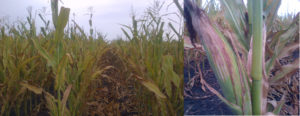
Reports of two spotted spider mite in some corn fields have been coming in. This pest is not normally a problem in corn but due to the hot, dry weather this year spider mites are showing up in numbers high enough to cause visible damage. Spider mite infestations start at the field edge and move inwards. On the corn plant, the mites will begin feeding on the lower leaves and move upwards as the population increases. When inspecting for mites check the end rows and walk into the field a good distance to determine if the mites have spread from the edge of the field. Damage from high populations of mites can be identified by stippling, yellowing or browning of leaves. Look on the underside of the leaves for mites to confirm that it is mite damage you have found. Smaller populations tend to colonize along the midrib of the leaf and large populations will spread out over the entire leaf and begin to lay down webbing. Damage may also be found on the cob husks.

Treatment options for spider mite in corn are limited in Ontario. The only product registered for spider mites on corn is Oberon and it is most effective when mite populations are lower but increasing. Effectiveness of the product is very limited when the used as a knock down insecticide on higher mite populations. Oberon is a contact miticide so good leaf coverage is essential especially on the lower leaf surface where spider mites feed. Review the product label for use rates and application instructions.
We do not have established treatment thresholds in Ontario for spider mites in corn however, the following link provides information on the treatment thresholds used in the Western United States http://www.ext.colostate.edu/pubs/insect/05555.html
If spider mite populations remain in the lower third of the plant then the corn may not experience significant stress from mite feeding to affect yields. If mite feeding begins to affect the cob leaf and above, then significant loss of leaf area in the upper canopy may have an affect on crop yields. Corn that received treatment with a broad spectrum insecticide for European corn borer may be at higher risk of developing spider mite problems as the insecticide may have reduced beneficial mite populations prior to the start of the infestation.
Once the corn has reached the early dent stage, treatments are no longer warranted!
Additional information on spider mites in corn including photographs of damage symptoms can be found at the following link:
Purdue University Extension:
http://extension.entm.purdue.edu/pestcrop/2012/issue19/index.html#spider